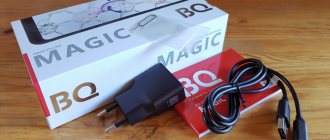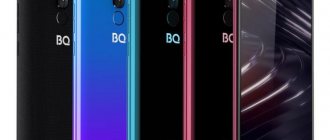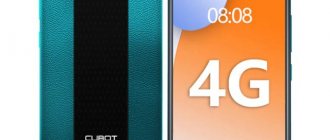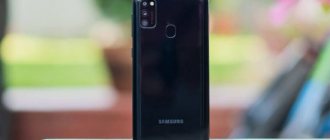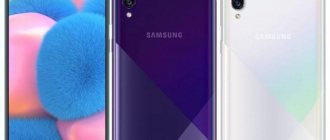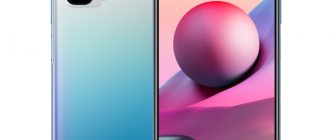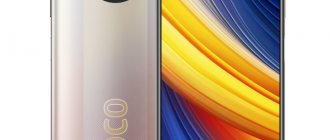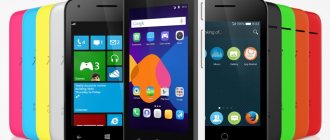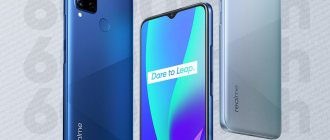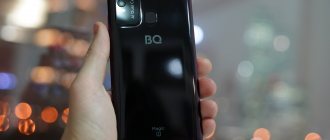The segment of devices up to 10 thousand shows the highest sales. This paradox has long existed that flagships and top-end devices are well-known, but are much less common in individual units among the population, which is simply explained by their too high price.
In 2022, the situation has become even more favorable for those who buy inexpensive devices. Manufacturers have once again mastered a new stage of technology, and those that yesterday were typical only for flagships have become available to those at a lower level. In short, modern budget devices have become much more interesting than a year or two ago.
Today we are testing the BQ Magic S (5731L) smartphone, which falls into the price segment mentioned above, but tries to look better than the devices we are used to seeing for this money. Let's put it to the test and see what the gadget is capable of.
Equipment
The boxes of the 2022 BQ devices literally offer a complete collection because they are designed in the same style, but the images on each are different, and they are not smartphones. If we saw a bike on the BQ Strike Power Max, then on the packaging of the BQ Magic S there is a Ferris wheel.
The box is a small rectangle made of hard cardboard. It is sealed in film and additionally sealed with branded adhesive tape. In front is the same attraction on a white background. Here we also find the brand logo and model name.
From the ends we see again the logo, information about the color of the smartphone inside, a sticker with serial number, IMEI numbers, production date, barcodes, etc.
On the back there is a bright red background with specifications, an indication of the scope of delivery, as well as brief information about the manufacturer and importer. Also, a reminder that BQ donates a portion of the funds to children's charities for every smartphone sold.
Inside there is a smartphone waiting for us, protective films here on the front and back, both of which we will gladly peel off, a USB-MicroUSB cable, a 1A/5V charger, a paper clip for removing the SIM card, as well as a warranty card and a short user manual on paper.
Detailed technical specifications
Make and model
Make and model of the device, and alternative names (if any).
| Brand Device manufacturer company. | BQ Mobile |
| Model Device name. | BQ-5731L Magic S |
| Alternative names Other model names, if available. Sometimes the model is called differently, depending on the country or because of popular nicknames. | 5731L |
Design
Appearance of the device including dimensions, weight, volume, colors and materials.
| Width The horizontal side of the device when used in standard orientation. | 71.9 mm (millimeters) |
| Height The vertical side of the device when used in standard orientation. | 148.8 mm (millimeters) |
| Thickness The cross-sectional size of the device. | 9.2 mm (millimeters) |
| Weight How much does the device weigh excluding the case, SIM and memory cards and other additional elements. | 155 g (grams) |
| Volume Approximate value calculated using the formula: length times width times height. | 98.43 cm³ (cubic centimeters) |
| Colors What colors is the device available in? | Dark Blue Wine Red Purple |
| Housing materials What materials is the body made of? | Plastic |
System on a Chip (SoC)
A system on a chip, a single-chip system (System on a Chip, SoC) is when several systems performing different device functions are connected on one chip.
| System on a Chip (SoC) A single-chip system that contains components such as a processor, graphics accelerator, memory units, communication interfaces, etc., as well as software for the operation of the system. | Unisoc SC9863A |
Central processing unit (CPU)
| Central processing unit (CPU) The main component of the device is responsible for calculations and data processing. | 4x 1.6 GHz ARM Cortex-A55, 4x 1.2 GHz ARM Cortex-A55 |
| Technical process What technological process is used to make the chip? The smaller the process technology, the better - the chips consume less power and generate less heat. | 28 nm (nanometers) |
| Processor size Processor capacity is a parameter that indicates how many bits of data a processor register processes in 1 clock cycle. This is usually 32 or 64 bits. | 64 bit |
| Instruction Set Architecture Instruction set architecture (ISA) is a programmable part of the microprocessor core used by software to control the operation of the processor. | ARMv8-A |
| Number of processor cores The processor can be either single-core or multi-core. The performance of the processor depends on the number of cores (threads). The more cores working simultaneously, the higher the power consumption, so in mobile devices all cores are used only under high load. | 8 |
| CPU clock speed Clock speed is the number of operations per second that a processor or its core can achieve. The higher the frequency, the higher the overall performance of the device, but performance also depends on the processor architecture and the number of cores. | 1600 MHz (megahertz) |
Graphics Processing Unit (GPU)
| Graphics Processing Unit (GPU) The graphics processing unit (GPU) is used to process and display graphics - 3D effects, games, interfaces and other visual elements. Due to the pipeline architecture, the GPU is many times more efficient in graphics processing than the processor. | PowerVR GE8322 |
Random access memory (RAM)
| Amount of random access memory (RAM) RAM (Random Access Memory, RAM, RAM) is temporary memory (works only while the device is running), which stores data and code for the operational operation of programs and applications. The more RAM, the more programs you can run simultaneously without loss of performance (there will be fewer “brakes”). | 3 GB (gigabytes) |
Built-in memory
Most mobile devices have built-in Flash memory, which is used as a storage for system data, the operating system, as well as user data - photos, videos, recordings and much more.
| Built-in memory capacity The higher the amount of built-in memory, the more games, programs, music, videos and your other files will fit in the device, especially the amount of memory is important when the device does not support memory cards. | 32 GB (gigabytes) |
Operating system
A mobile operating system (OS) is pre-installed software with a well-thought-out interface for user control of device functions.
| Operating system (OS) The operating system installed by default by the device manufacturer, as well as its version. | Android 9.0 Pie |
Battery
To operate autonomously, a mobile device requires a battery that powers all its components.
| Battery capacity The main characteristic of a battery is its maximum capacity, that is, the charge it can store. Capacity is measured in mAh (mAh, milliamp-hour). The higher the capacity, the longer the mobile device can work. | 3650 mAh (milliamp-hours) |
| Battery type Many types of batteries have been used in portable devices, but NiCd (nickel-cadmium), NiMH (nickel-metal hydride), and even more so SLA (lead-acid) batteries are already considered obsolete. Instead, modern mobile devices use Li-Ion (lithium-ion) and Li-Pol, Li-Poly (lithium-polymer) batteries. | Li-polymer |
| Power adapter Characteristics of the charger (adapter, power supply) included in the standard package of the mobile device. More precisely, the output voltage in volts (V) and the output current in amperes (A). | 5 V (volts) / 1.55 A (amps) |
Screen
The screen (display) is the main element for displaying graphic information.
| Technology The technology used to make the screen. There are many types of display manufacturing with their pros and cons. | IPS |
| Diagonal The screen diagonal of a device is measured in inches (inch, in or simply ″), and 1″ is equal to 2.54 cm. | 5.84 in (inches) 148.34 mm (millimeters) 14.83 cm (centimeters) |
| Width Approximate screen width | 63.5 mm (millimeters) 6.35 cm (centimeters) |
| Height Approximate screen height | 134.06 mm (millimeters) 13.41 cm (centimeters) |
| Aspect Ratio Aspect ratio is the ratio of the shorter side of the screen, which is considered to be 1, to the longer side, which is denoted by a decimal fraction indicating the ratio to the short side. | 2.111:1 |
| Screen resolution Screen resolution is the number of horizontal pixels (dots) multiplied by the number of vertical pixels. The higher the resolution, the more detailed the image will be. | 1080 x 2280 pixels |
| Pixel Density The number of pixels per inch or PPI (pixels per inch) indicates the density of pixels per 1 inch (2.54 cm) of the screen. The higher the PPI, the sharper the image, and the less visible or even invisible “squares and dots” (pixels). | 432 ppi (pixels per inch) 169 ppcm (pixels per centimeter) |
| Color depth Color depth means how many bits are used in 1 pixel to display color (bits per pixel). | 24 bit 16777216 colors |
| Screen area Approximate usable area occupied by the screen on the front of the device. The higher the percentage, the narrower the frames around the display or the smaller the “chin with bangs.” | 79.82% (percent) |
| Touch screen A touch screen is a device that usually covers the display and is a touch input tool. In fact, in mobile devices, the touchscreen is a replacement for the keyboard and mouse. | Yes |
| Touch screen type There are many types of touch screens, with their pros and cons. Mobile devices often use capacitive touchscreens, but technology does not stand still and new types of sensors are appearing. | Capacitive |
| Multi-touch Touch screen support for two or more touches. For example, zooming photos with two fingers. | Yes |
| 2.5D screen 2.5D is a display with rounded edges. Device manufacturers use a 2.5D screen as a design element, for a pleasant tactile sensation, or to add durability, dust and moisture protection. | Yes |
Main camera
The main camera, usually built into the rear of the device, is designed for creating photo and video content.
| Maximum image resolution This is the maximum number of pixels (dots) horizontally and vertically. The higher the resolution, the more detailed the image will be. Resolution can also be indicated in megapixels - this is the total number of pixels that can be in the image, calculated by the formula: vertical pixels multiplied by the number of horizontal pixels and divide the resulting amount by 1 million. | 16 MP (megapixels) |
| Flash type Most mobile devices are equipped with light-emitting diode (LED) flashes, but there are also xenon flashes. As a flash, xenon is better - it is more powerful, but LED is more versatile (can work as a flashlight) and consumes less electricity. | LED |
| Maximum video resolution This is the maximum number of pixels (dots) horizontally and vertically. The higher the resolution, the more detailed the image will be. | 1920 x 1080 pixels 2.07 MP (megapixels) |
| FPS video recording at maximum resolution FPS (Frames per Second, frame rate) is the number of frames that changes in 1 second. The higher the number of frames per second, the smoother the image will be. In this case, we mean the number of frames that the camera can achieve at its maximum resolution; the lower the resolution, the higher the FPS can be. | 30 fps (frames per second) |
| Presence of flash Incorporating a flash into a mobile device allows you to take pictures in low light conditions. Creates the necessary lighting and compensates for the lack of natural light. | Yes |
| Digital zoom With digital zoom (zoom, enlargement), the subject is brought closer due to software image algorithms. The higher the magnification with digital zoom, the worse the image quality (noise, blur) will be compared to a non-zoomed one. | Yes |
| Focus on face Function of auto-detection of living objects and autofocus on their face or head. | Yes |
| Panoramic shooting mode Panoramic photography is a series of frames where each subsequent frame is a continuation of the previous one; at the end of the shooting, all frames are stitched together at the software level to create a panoramic photograph. Frames can be shot both vertically and horizontally, and their width can be up to 360 degrees. This type of shooting is used when the camera's viewing angle is not enough to capture the entire scene. | Yes |
| HDR shooting mode HDR photography takes a quick series of shots with highlights, midtones, and shadows, then combines them into a single frame with high dynamic range. | Yes |
| White balance White balance is a setting that helps ensure the correct color reproduction in an image by determining the color temperature of the light source in the frame. The balance can be set either automatically or manually. | Yes |
| ISO Setting ISO is the level of light sensitivity. The lower the ISO, the less sensitive the camera's light sensor and the smoother the image with less noise. The higher the ISO, the higher the light sensitivity, but more noise, graininess, or decreased sharpness. | Yes |
| Additional Information Additional information about the functions and characteristics of cameras. | Autofocus Continuous shooting Geo-tagging Touch focus Exposure compensation Self-timer Scene selection mode Phase detection autofocus (PDAF) |
Additional cameras
Secondary cameras allow you to expand the capabilities of the main camera, such as adding a wide shooting angle, sharpness, optical zoom and other functions depending on the type of secondary camera.
| Second additional camera | 0.3 MP (megapixels) |
Front-camera
The front camera of a mobile device (selfie camera, rear camera) is a camera on the front part, which is usually used for video communication, recognition of gestures or faces, and selfie photographs.
| Photo resolution The maximum image resolution that the camera can produce. As resolution increases, image detail increases. Resolution can also be indicated in megapixels (the total number of pixels that an image can consist of) - these are vertical pixels multiplied by horizontal pixels and divided by 1 million. | 16 MP (megapixels) |
| Video resolution This is the maximum resolution the camera can record video at. The higher the resolution, the better. | 1920 x 1080 pixels 2.07 MP (megapixels) |
| Frame rate (FPS) of video shooting This is talking about FPS at maximum video resolution; at lower resolutions, the frame rate per second can be higher. FPS determines the smoothness of the video, as well as the ability to speed up or slow down it. | 30 fps (frames per second) |
Memory card
A memory card (flash card) is an external data storage device that is used in many devices to increase memory capacity.
| Memory card type and formats Mobile devices usually use 3 types of memory cards - SD, miniSD and the most common microSD. Each type has its own formats that the device supports. | microSD microSDHC microSDXC |
SIM card
Subscriber Identification Module (SIM) used in mobile devices to identify subscribers in cellular networks.
| Type, size of SIM card A regular (mini SIM) card has dimensions of 25x15 mm. Micro SIM - 15x12 mm. Nano SIM - 12.3x8.8 mm. The sizes of SIM cards are different and not interchangeable. There is also an eSIM (virtual, electronic SIM card), it is built into the device and does not take up space. | Nano-SIM (4FF - fourth form factor, since 2012, 12.30 x 8.80 x 0.67 mm) |
| Number of SIM cards How many SIM cards does the device support? | 2 |
| Additionally Additional information about the operation of SIM cards in the device. | Dual SIM stand-by (Both cards are active. When one is busy talking, the other is deactivated.) |
Mobile networks
This is a system in which communication and data transfer is carried out between subscribers, the location of one or more of which changes. This section lists the supported mobile communication standards and frequencies.
| GSM GSM (Global System for Mobile Communications) is a standard for digital mobile cellular communications of the second generation 2G with time and frequency division of channels. GSM came to replace analog cellular communications 1G (first generation). | GSM 850 MHz (B5) GSM 900 MHz (B8) GSM 1800 MHz (B3) GSM 1900 MHz (B2) |
| LTE LTE (Long-Term Evolution, often referred to as 4G LTE) is a standard for wireless high-speed data transmission, which, although it belongs to fourth generation networks (4G), is essentially a transitional stage from 3G to 4G, greatly accelerating data transfer speeds. The standard has an improved version, LTE Advanced (LTE-A), which can already be considered a full-fledged 4th generation network. | LTE-FDD 800 MHz (B20) LTE-FDD 1800 MHz (B3) LTE-FDD 2100 MHz (B1) LTE-FDD 2600 MHz (B7) |
| WCDMA WCDMA (W-CDMA, Wideband Code Division Multiple Access) is a third generation mobile communication standard (3G), which is an add-on to GSM and provides high-speed Internet access. | W-CDMA 900 MHz (B8) W-CDMA 2100 MHz (B1) |
Mobile network data standards
What data transfer standards in cellular networks are supported by the device, as well as their speed.
| Data transmission technologies Technologies for receiving and transmitting data, as well as their maximum speed. | UMTS (384 kbit/s) EDGE GPRS HSPA+ LTE Cat 6 (51.0 Mbit/s, 301.5 Mbit/s) |
WiFi
Wi-Fi (Wireless Fidelity) is a technology for wireless data transmission over a local network among devices based on IEEE 802.11 standards.
| Wi-Fi Direct support The Wi-Fi Direct protocol allows multiple devices to connect directly, bypassing the use of routers or access points. | Yes |
| Wi-Fi Hot-Spot A hotspot is a Wi-Fi access point. In a mobile device, Hot-Spot turns the smartphone into a Wi-Fi access point, essentially turning it into a router capable of distributing the Internet. | Yes |
| WiFi Supported WIFI wireless network standards. | 802.11b (IEEE 802.11b-1999) 802.11g (IEEE 802.11g-2003) 802.11n (IEEE 802.11n-2009) |
Bluetooth
Bluetooth (BT, bluetooth (z), “blue tooth”) is a short-range wireless network (up to 10, sometimes 100 meters) operating on radio waves to transmit voice and data between devices.
| Bluetooth version Bluetooth technology is actively developing and, since 1998, has been constantly updating versions of the standard. Each subsequent version introduces one or several improvements in data exchange speed, range, facilitates pairing, reduces power consumption, or introduces some new protocols and operating profiles. The higher the Bluetooth version, the better. The technology is also backward compatible, for example, if your mobile device has version 5.0, then it will work with accessories version 4.2 and lower, but the improvements introduced in version 5.0 will not work; they will work only if both the device and accessories are version 5. | 4.2 |
| Bluetooth Low Energy (BLE) Bluetooth LE is a low energy BT protocol specification. | Yes |
| A2DP profile The A2DP Bluetooth profile is designed to transmit a high-quality two-channel stereo signal via Bluetooth to wireless headphones, speakers and other acoustics. | Yes |
Sensors
Modern devices have many sensors that help in measurements, trigger functions, and make using the device more pleasant.
| Light sensor The light sensor reacts to the light level and is able to adjust the screen brightness automatically based on this. This is necessary to reduce power consumption and ease of use of the device. | Yes |
| Proximity sensor The proximity sensor reacts to the proximity of the mobile device to some object. For example, the sensor is used when talking on the phone to turn off the screen, which saves energy and prevents you from pressing buttons with your ear or cheek. | Yes |
| Accelerometer An accelerometer is a sensor that measures apparent acceleration, that is, it determines the position and distance at which a mobile device moves in space. Based on the data from this sensor, the screen orientation change, pedometer, control using tilts and gestures in games and applications, etc. work. | Yes |
| Fingerprint's scanner The scanner is responsible for authorization using a previously saved fingerprint, as a result of which the device is unlocked, payment is made, some action is confirmed - just put your finger on the scanner. Scanners can be either built into the body or built into a button or screen. | Yes |
| Additional sensors |
Audio
Audio - characteristics and capabilities of a mobile device in terms of sound.
| Music speaker There are two types of speakers in mobile devices - auditory and musical. The auditory speaker (speaker) is used for conversation, the music speaker (buzzer) is used to play music and sounds. | Loudspeaker Earphone |
Radio
The radio in a mobile device can be built-in by the manufacturer (catch local radio channels, no internet required, often works only with headphones (as an antenna), but not always) or installed as an online application (requires internet, but more channels and often better quality) .
| Built-in radio Is a radio tuner integrated into the mobile device? | Yes |
Navigation and location
The location is determined by satellite navigation systems that track the device's autonomous geospatial location at multiple points. The most common satellite navigation systems are GPS, GLONASS, and the Chinese BeiDou.
| GPS GPS (Global Positioning System) is a global satellite navigation system that can determine the position of a mobile device, build routes and find the desired object on the map with an accuracy of several meters. | Yes |
| A-GPS A-GPS (Assisted GPS) is an assistive technology that will help you quickly find the location of your cellular device without waiting for satellite data, which is especially important in indoors and cities. Location is determined in various ways, for example, Wi-Fi access points, mobile towers, bluetooth and others. | Yes |
| GLONASS GLONASS is a Russian Global Navigation Satellite System, which is similar to GPS and works in tandem with it, increasing the accuracy and speed of navigation. | Yes |
| Additional navigation systems |
USB connector
USB (Universal Serial Bus) is a serial interface for connecting peripherals to computers, smartphones, laptops and much more. The interface allows you to exchange data and power a peripheral device with energy, as well as connect several peripheral devices to one USB connector at once.
| Connector type What type of USB connector is used in the device. | Micro USB |
| USB standard The higher the standard, the faster the throughput, or more precisely the data exchange rate. With version 3.0 of the standard, the current was increased to 0.9A, eliminating the need for additional power for some devices. | 2.0 |
| USB Mass Storage Connecting a mobile device via USB as a data storage device. That is, when you enable this mode, your device can be used as a flash drive. | Yes |
| Additional characteristics Additional features of the USB connector, for example, OTG, whether the connection is supported, peripheral devices and additional memory. | Charging via USB |
Headphone jack
A TRS headphone jack (or jack) is a common standard of connectors used for transmitting audio signals. By diameter there are jack (6.5 mm), mini-jack (3.5 mm) and micro-jack (2.5 mm). In mobile devices, the 3.5mm jack was considered the most popular and widespread, but recently they began to be removed, leaving only USB connectors, through which headphones are connected with a corresponding plug or using adapters.
| 3.5mm headphone jack Does the device have a 3.5 mm audio jack? | Yes |
Connection and synchronization
Options for synchronizing your mobile device and connecting it to other devices.
| NFC NFC (Near field communication, near contactless communication) is a technology for contactless communication between devices over a short distance. Widely used for contactless payment, in the form of a travel card or pass, and is also used for reading and interacting with NFC tags and for exchanging data between devices. | Yes |
| Connection, synchronization Types of synchronization and connection technologies supported by the device. | Computer sync OTA sync Tethering |
Browser
A browser is a browser program for viewing sites and their content on the Internet. Through the browser, you can open websites, search for information, download necessary files, watch streaming videos, play browser games, etc.
| Technologies Markup and programming languages supported by the built-in (standard) browser. For mobile devices, you can install additional browser applications if the standard one does not suit you. | HTML HTML5 CSS 3 |
Audio file formats/codecs
Mobile devices support many audio file formats, as well as codecs for playing them.
| Default formats The formats that the mobile device supports out of the box are indicated. But if the device does not support the format you need, then you can try adding support for it. Sometimes support depends on the technical characteristics of the device (“hardware”) and nothing can be added here, but often the ability to process a particular audio format depends on the software part. You can install another audio player or codec set separately. | AAC (Advanced Audio Coding) AMR / AMR-NB / GSM-AMR (Adaptive Multi-Rate, .amr, .3ga) eAAC+ / aacPlus v2 / HE-AAC v2 FLAC (Free Lossless Audio Codec, .flac) MIDI MP3 (MPEG) -2 Audio Layer II, .mp3) OGG (.ogg, .ogv, .oga, .ogx, .spx, .opus) WMA (Windows Media Audio, .wma) WAV (Waveform Audio File Format, .wav, .wave ) |
Appearance, build quality and materials
We felt that the appearance was one of the BQ Magic S's strongest points.
Firstly, it is compact, so it feels very comfortable in the hand. It is comfortable to use. At the same time, it cannot be called small in any case. It’s just a couple of millimeters narrower, a couple of millimeters shorter, but this greatly adds to the practicality. So that you don’t worry, the screen is large, the diagonal is stretched to 5.84 inches.
The form factor is a classic monoblock.
Secondly, the buttons located on the right side are very pleasant to press. Softly and silently. This is a separate tactile pleasure. The volume rockers and power button are located on the right side.
On the left we see a slot for SIM cards and a memory card, three compartments.
The top one houses a 3.5 mm headphone jack.
On the bottom we find a port for connecting MicroUSB, as well as two perforations for an external speaker and microphone. There is no second microphone in this model.
In front, the entire space was allocated for a screen with a small “bang” that housed a selfie camera, earpiece and sensors. At the bottom there is a thickening of the frame, which draws on a small, neat chin. The top and side frames are narrow and approximately the same thickness. It looks good.
The “back” of the device is gradient and mirrored, in our case it is dark green and its shades.
In the upper left corner there is a dual camera, slightly protruding from the body, with a flash immediately below it. A little lower and “along the spine” is a black fingerprint scanner, under which we see the brand logo. At the very bottom center is the model name.
It seems the smartphone got its name Magic S because of its gradient cover. It is rounded on the sides, which improves the grip. In general, it looks like devices from a more expensive segment. The only thing that gives away the plastic here is the absence of a frame connecting the “back” and the screen.
BQ-5731L Magic S: test results
We tested the BQ-5731L Magic S on AnTuTu Benchmark, where it scored 105,643 points. The smartphone also went through several runs in the 3DMark, PCMark, Geekbench benchmarks and the AI Benchmark program, which evaluates the “intelligence” of modern phones. To measure the speed of your Internet connection via Wi-Fi, we used the Speedtest utility. In addition, we ran the VR Checker test on the smartphone, which found that this mobile phone is suitable for playing VR and 360-degree content due to the lack of a gyroscope and accelerometer. Detailed test results can be found below.
| Benchmark | Test results |
| AnTuTu Benchmark | 105,643 points |
| AnTuTu Multitouch Test | Recognizes 5 clicks |
| Geekbench 4 Single-Core | 850 points |
| Geekbench 4 Multi-Core | 3516 points |
| PCMark Work Performance 2.0 | 4417 points |
| PCMark Computer Vision | 2702 points |
| PCMark Storage | 18,056 points |
| 3DMark Ice Storm / 3DMark Ice Storm Extreme | 9699/- points |
| 3DMark Sling Shot / 3DMark Sling Shot Extreme | 564/- points |
| AndroBench (read files in internal memory) | 95.57 MB/s |
| AndroBench (write files to internal memory) | 88.69 MB/s |
| AnTuTu AI Benchmark | 41,690 points |
| AI Benchmark | 2613 points |
| Speedtest (max. download speed over 4G/Wi-Fi) | 5.58/5.72 MB/s |
| Speedtest (max. download speed over 4G/Wi-Fi) | 2.60/5.23 MB/s |
| VR Checker | Not suitable for working with VR content |
Did you like the article? Share with your friends!
At work and at play
First, let's talk about the speed of the system's response to user actions and launching applications. Basically, in 2022, if we take a really fresh device, even a budget one, everything has become noticeably better. That is, the system works in such a way that it does not irritate even us, although we are used to seeing flagships with much more powerful hardware.
In short, there are no constant lags, and applications launch reasonably quickly, so we won’t call the device thoughtful. The successes of processor manufacturers and Google optimization are noticeable, since BQ uses pure Android on its gadgets, as well as an increased amount of RAM - 3 GB. Previously, this was found in more expensive devices.
The amount of RAM allows the smartphone to keep the latest and most frequently used applications in memory without unloading, which reduces the time they are displayed after a download request. Even heavy games easily live in your memory, without interrupting your progress if you switch for a while to, say, answer an important letter or message.
Our verdict is that the BQ Magic S will cope with typical tasks for most people without any problems, and you can use any modern applications available in the Google Play Store.
By the way, a good indicator is that when you need to enter data, Gboard, installed here by default, pops up on the screen quickly and does not load every time.
Of course, we remembered our checklist of games to see how good the smartphone's graphics capabilities would be. Let's check it on modern three-dimensional games, since it definitely plays movies without problems.
Our list today: PUBG Mobile, Call of Duty Mobile, Mortal Kombat, Asphalt 9, World of Tanks Blitz, Need for Speed No Limits, Shadowgun Legends.
PUBG launched, offering to play on minimum graphics settings. At the same time, the toy looks quite nice and does not slow down, except that in some places there is not enough smoothing.
Call of Duty also rated its graphical capabilities below average, but it is so well developed that it looks even prettier than PUBG and also does not slow down, which is the main thing in shooters, where it is important to be able to aim quickly and accurately.
Mortal Kombat traditionally looks impressive and does not complain about performance. The situation is similar with World of tanks, which runs in our country even on very weak devices.
Shadowgun Legends launched, the graphics settings are at a minimum judging by the picture quality, but modern heavy games even with low graphics quality look presentable. However, Shadowgun has another feature - in some locations it slows down, you will encounter jerks quite often.
But everything is good in Asphalt 9 and good in Need for Speed. In the games listed above, the smartphone heats up quite a bit.
In a word, there will be something to occupy yourself with if you have a lot of free time. In addition, simpler or casual toys will launch without problems; they exist in huge quantities in the Play Store.
We were very impressed by the cold start of the GPS module: 4 seconds, and the smartphone was already hooked up to the satellites.
Another three-letter module will definitely appeal to customers - NFC is available. Contactless payment, checking the balance of your Troika - this is possible with BQ Magic S.
As for the quality of voice calls, everything is quite standard, although there is no noise reduction during a call. The interlocutor hears you, you hear him, we didn’t notice any problems. This moment today generally depends no longer on the device, but on the quality of network reception and operator coverage, the operation of the base station to which the smartphone is connected. If everything is ok with this, then you can talk without problems or interference.
Autonomy here is also quite typical. One day without worry under typical load, the next day it is better to recharge the smartphone, although it will still last less than a full day.
And, by the way, it turns off cool. Android can dim the screen smoothly, but not all vendors use this, although it looks very nice. BQ chose this particular method of going into sleep mode.
⇡#Camera
The BQ-6040L Magic boasted an unexpectedly good combination of rear cameras for a smartphone in its price category - without optical zoom, but with a fully functional software one. The BQ-5731L Magic S model also received two rear cameras, but, alas, without zoom.
The main module is equipped with a 16-megapixel sensor and an ƒ/2.0 lens. The second is auxiliary, with a 0.3 megapixel sensor. It is needed solely for blurring the background in portrait mode. It copes with this, I must say, very well - the Magic S is generally positioned as a smartphone for portraits. To do this, it has two modes in its arsenal: the one of the same name, with adjustable background blur, and the “Beauty” mode, with a built-in beautifier.
Portrait mode is good not only in daylight, but also in the dark - and you can adjust the “aperture” manually. There are practically no blurring artifacts, and facial detail is very good.
| Left – picture without HDR, right – with HDR | ||
When shooting basic scenes, it's surprising that HDR is turned off by default. I recommend that you immediately go to the quick settings of your smartphone camera and turn on automatic HDR shooting - this will greatly help in situations with contrasting lighting, and not only that. The dynamic range of the camera is very weak, and without HDR it may not be enough even in cloudy weather.
| On the left is a picture with standard settings, on the right is in night mode | ||
The BQ Magic S is not suitable for shooting in low light conditions. The special night mode, in which the smartphone combines multi-frame exposures, is not particularly helpful. As you can see in the examples above, it is not always possible to distinguish between pictures taken in standard format and at night. Well, getting an unblurred night shot on the Magic S is quite difficult - but at least it’s possible.
| BQ-5731L Magic Camera APP Interface | ||||
The BQ Magic S copes with daytime scenes more or less confidently - I note warm (sometimes excessively) color rendition, satisfactory detail and noise, noticeable even in ideal lighting. In general, for a smartphone in this price category, the photo quality is normal - with the exception of portraits, which the Magic S does really well.
Gallery of pictures
View all images (18)BQ Magic S can shoot video with resolutions up to Full HD at up to 30 frames per second.
The BQ's description of the Magic S puts the same emphasis on taking selfies as it does on taking portraits - and when you look at the characteristics of the front camera, it seems that this is quite reasonable. These are the characteristics: 16 megapixels, aperture ƒ/2.0. Indeed, good background blur is provided even in this mode, and the smartphone recognizes a face in the frame, despite the lack of autofocus.
Security and personal data
The smartphone is equipped with a classic fingerprint scanner. The technology has long been debugged, so we have no complaints about it. Recognizes clearly and quickly.
In addition, there is the possibility of face unlocking. It also works quickly, even in the evening with electric light. Of course, it won’t work at night in the dark, since there are no appropriate sensors.
Magic line smartphones
In addition to the BQ-5731L, the series includes the more affordable BQ 5730L Magic C with gradient colors, a 2/16 GB memory ratio, NFC support, an HD+ screen and a 2700 mAh battery. The device is suitable for undemanding users who want a modern device for 6,990 rubles.
The first representative of the “magic series” was the balanced BQ-6040L Magic, which featured a 4000 mAh battery and a 6.09-inch screen. We have a separate review dedicated to it.
System software
BQ pre-installs some partner applications on its devices, but the company is not stubborn and gives the user complete freedom. If you don’t need them, you can remove them using standard system tools.
Among our key partners we see Yandex with its products. For example, you can use Alice as a voice assistant, or surf the Internet through a proprietary Russian browser, and not through a product from Google.
The smartphone runs on Android 9 Pie.
Benchmarks
Below is how the smartphone tested in the popular AnTuTu benchmark in various types of testing.
As well as its results in PCMark.
In addition, achievements in Geekbench, the speed of the internal storage device, the partitioning of the system disk, as well as the capabilities of the Wi-Fi network, limited to a speed of 200 Mbit/sec.
BQ-5731L Magic S: wireless modules and communication
As we already mentioned at the very beginning of the review, the BQ company tries to equip its smartphones with everything necessary, which is why there is an NFC module here. Considering that many competitors from China simply refuse this option, then BQ smartphones are on top here. An LTE modem and Wi-Fi are used to connect to mobile and wireless networks, and GPS, AGPS and GLONASS sensors are used for navigation. A cold start when activating the navigator cannot be called fast, so you will have to wait 15-20 seconds until the phone determines its location.
Camera
Examples of camera shots can be seen below.
The camera can work in beauty mode, night mode and portrait mode, creating a bokeh effect in software. Here it is worth taking into account that this looks fine from a smartphone. But on a large PC screen, it becomes clear where the algorithms did not work very well, blurring out something unnecessary, or leaving a sharp edge in some part of your silhouette.
The original photos can be downloaded from the link.
Specifications
| Screen diagonal: | 5.84 inches |
| Screen resolution: | 2280x1080 FHD+ |
| Screen technology: | IPS |
| Battery: | 3650 mAh |
| Mobile Internet: | 4G/LTE |
| CPU: | UNISOC SC9863A, 1.6 GHz |
| Number of Cores: | 8 |
| Operating system: | Android 9.0 |
| RAM: | 3 GB |
| Built-in memory: | 32 GB |
| Memory card support: | MicroSD 128 GB |
| SIM quantity: | 2 |
| Wireless connection: | GSM 850/900/1800/1900 MHz, WCDMA 900/2100 MHz, GPRS, EDGE, 4G Cat.6, Wi-Fi IEEE 802.11 b/g/n, Bluetooth 4.2 |
| Main camera: | 16+0.3 MP |
| Front camera: | 16 MP |
| Navigation: | GPS, AGPS, GLONASS |
| Dimensions: | 148.8 x 71.9 x 9.2 mm |
| Weight: | 155 g |
| Contactless payments: | NFC |
| Fingerprint's scanner: | Eat |
⇡#Hardware and performance
The BQ Magic S has a hardware platform that may be familiar to you from other brand smartphones presented in this price range. We are talking about UNISOC SC9863A.
The platform consists of eight cores: four ARM Cortex-A55 with a clock frequency of 1.6 GHz and four of the same, but with a lower clock frequency of 1.2 GHz. Graphics coprocessor – IMG8322, also known as PowerVR GE8322. The technological process used to produce the platform is 28 nm. It also includes an LTE modem and supports Full HD screens, which is important for the Magic S.
The smartphone is not particularly impressive in its performance, but a significant part of the games from the Google Play catalog will work on it, and basic applications open without problems. General work with the operating system is leisurely, the response speed of the BQ Magic S is no different, but we can talk about stability - it does not freeze; During testing, not a single situation arose that would require rebooting the gadget.
The BQ Magic S uses a very efficient cooling system. Yes, its task is quite simple - to cope with the heat dissipation of the not very powerful UNISOC hardware platform, but 89% of the maximum frequencies in the synthetic CPU Throttling Test are still impressive. The average productivity was 81 GIPS.
The BQ Magic S has 3 GB of RAM – quite enough for a smartphone with a Full HD screen. The drive is 32 GB, and there is nothing to be happy about. It is best to immediately purchase a memory card, since it has a separate slot that does not overlap any of the SIM card slots. MicroSD up to 128 GB is supported.
